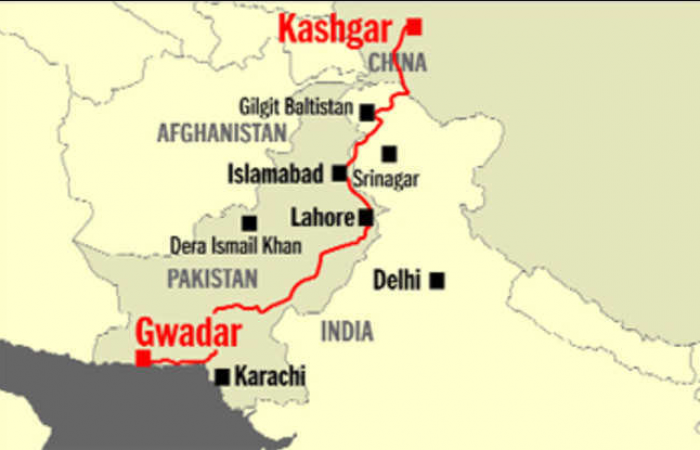
Beijing/Islamabad- In a significant development under China's expansive Belt and Road Initiative, China and Pakistan have joined hands to construct a groundbreaking economic corridor. This ambitious endeavor is poised to foster trade and investment between the two nations, bring about infrastructural transformation, and catalyze economic growth.
The Agreement and its Significance
The agreement, inked during a meeting between Chinese President Xi Jinping and Pakistani Prime Minister Shehbaz Sharif on September 9, 2023, solidifies their commitment to this visionary project. The corridor will link the Chinese city of Kashgar to the Pakistani port of Gwadar, weaving an intricate web of roads, railways, and pipelines. With an estimated cost of $60 billion, the project is projected to be completed by 2025.
Also Read: Sri Lanka Declares State of Emergency Amidst Severe Economic Crisis
Economic Boost and Trade Surge
The China-Pakistan Economic Corridor (CPEC) holds the promise of a substantial 30% surge in trade between the two nations. Beyond trade, it is poised to usher in employment opportunities and spur economic growth in both China and Pakistan, touching lives and communities along its path.
China's Belt and Road Initiative
Embedded within the broader framework of China's Belt and Road Initiative (BRI), the CPEC emerges as a flagship endeavor aimed at expanding infrastructure development worldwide. While the BRI has garnered both acclaim and criticism on the international stage, it remains a cornerstone of China's global engagement.
Also Read: Iran Nuclear Talks Resume in Vienna: Hopes and Challenges
A Mutually Beneficial Project
China and Pakistan contend that the CPEC stands as a mutually beneficial endeavor. It is envisioned to propel economic growth, development, and connectivity in both countries. This shared vision underscores the collaborative spirit underpinning this colossal infrastructure project.
The Key Benefits of the CPEC
Enhancing Trade and Investment: The CPEC's potential to boost trade and investment between China and Pakistan is paramount. By creating efficient transportation routes and connectivity, it facilitates the movement of goods, services, and capital.
Economic Growth and Job Creation: Economic growth and employment generation are at the heart of the CPEC. As industries and infrastructure flourish along the corridor, new job opportunities will be created, driving economic prosperity.
Connecting to Global Markets: The corridor establishes a direct link between China and the Arabian Sea and the Indian Ocean through the port of Gwadar. This strategic advantage opens up access to global markets for both nations.
Infrastructure Development: The CPEC represents a significant infusion of infrastructure development in Pakistan. Roads, railways, and pipelines will be constructed, paving the way for improved transportation and logistics.
Promoting Regional Cooperation: By bridging the gap between China and Pakistan, the corridor encourages greater regional cooperation. It acts as a catalyst for enhancing connectivity among neighboring countries.
Challenges and Considerations
The CPEC is not without its share of challenges and considerations:
Environmental Impact: Large-scale infrastructure projects often raise environmental concerns. The CPEC will need to incorporate sustainable practices and consider the ecological footprint of its development.
Geopolitical Dynamics: Geopolitical considerations play a significant role in the success and acceptance of projects like the CPEC. It will be important to navigate regional dynamics and diplomatic sensitivities.
Financing and Economic Viability: The successful completion of the CPEC hinges on securing adequate financing and ensuring its economic viability. Sustaining such a massive project over the long term is a complex endeavor.
Technical Challenges: Overcoming technical challenges related to construction and maintenance is a critical aspect of the CPEC's implementation.
The Road Ahead
The realization of the CPEC's potential hinges on numerous factors. These include the unwavering commitment of the Chinese and Pakistani governments, securing sustainable financing, and overcoming technical and logistical hurdles. While challenges abound, the project holds immense transformative potential.
A Path to Economic Prosperity and Connectivity
The China-Pakistan Economic Corridor represents more than just a physical infrastructure project; it is a path to economic prosperity and connectivity. By fostering trade, investment, and infrastructure development, the corridor has the power to uplift communities, stimulate growth, and forge stronger ties between nations.
Also Read: EU and US Forge Alliance to Bolster Energy Security Amid Ukraine Conflict
The agreement between China and Pakistan to construct the China-Pakistan Economic Corridor underscores the transformative impact of infrastructural projects in the modern world. While challenges must be addressed, the potential benefits are vast.
The CPEC symbolizes a bridge between nations, offering economic growth, connectivity, and cooperation. As it unfolds, the world watches with anticipation, recognizing that the success of this corridor could reshape the landscape of trade and connectivity in the region and beyond.